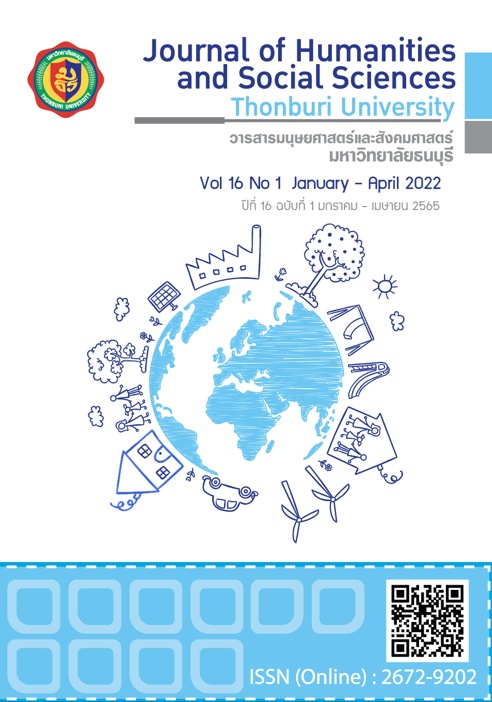Active Learning to Develop Higher Order Thinking: Meta-Analysis
Keywords:
Active Learning, Higher order thinking, Meta-Analysis, Effect sizeAbstract
The objective of this research is to discover and compare the effect size of research related to active learning that affects higher-order thinking. The selected articles can be divided into 3 sub-groups: critical thinking, creative thinking, and analytical thinking. They were searched from the Thai Journal Citation Index Center (TCI) database and passed the research quality assessment based on the type of validity. Moreover, they must qualify for calculating the influence size. The sample group is 43 articles or 45 effect sizes. Calculation of effect size is analyzed using the Meta-Essentials program. The program found that the distribution of effect size was high. The mean of effect size is 1.79, the 95% confidence interval is between 1.44 to 2.14. In addition, when analyzed by subgroups of thinking types, when analyzed by subgroups of thinking types, the mean of effect size of active learning to improve analytical thinking from higher to lower, critical thinking, and creativity were 2.57, 1.38 and 1.13, respectively. In each subgroup, there was a high distribution of effect size. Active learning, which has an effect size higher than the mean score, is selected. There are utilized in the specific instructional model development that only higher-order thinking.
References
ฉัตฑริกา อภิชนังกูร, สิริสวัสช์ ทองก้านเหลือง และวัฒนา รัตนพรหม. (2563). การสังเคราะห์งานวิจัยที่เกี่ยวกับรูปแบบการจัดการเรียนการสอนที่ส่งผลต่อผลสัมฤทธิ์ด้านการอ่านภาษาอังกฤษ ของนักเรียนชั้นมัธยมศึกษาตอนปลาย โดยวิธีการวิเคราะห์อภิมาน. วารสารวิชาการหลักสูตรและการสอน มหาวิทยาลัยราชภัฏสกลนคร ฉบับออนไลน์. 12(35): 155-166.
ญาณี กลั่นภูมิศรี, อนุชา วัฒนาภา, เอกรัตน์ รวยรวย และ วิศิษฏ์ศรี วิยะรัตน์. (2560). การปรับเปลี่ยนห้องเรียนไปสู่ การเรียนรู้เชิงรุกโดยวิธีกระบวนการในรายวิชา ทางด้านวิศวกรรมอุตสาหการ. วารสารนวัตกรรมการเรียนรู้. 3(1): 3-28.
ณฐกร ดวงพระเกษ, ประพันธ์ศิริ สุเสารัจ, และลัดดาวัลย์ เกษมเนตร. (2560). รูปแบบการจัดการเรียนรู้เชิงรุกโดยใช้ปัญหาเป็นฐาน เพื่อส่งเสริมสมรรถนะนักศึกษาการศึกษานอกระบบและการศึกษาตามอัธยาศัย. วารสารวิชาการศึกษาศาสตร์. 18(2): 209-224.
นิติบดี ศุขเจริญ, และวัยวุฑฒ์ อยู่ในศิล. (2557). การวิเคราะห์อภิมาน และการสังเคราะห์อภิมาน. วารสารมหาวิทยาลัยราชภัฏมหาสารคาม. 8(3): 43-55.
ปราณี พิพัฒน์สถิตกุล, อิทธิพัทธ์ สุวทันพรกูล และอรอุมา เจริญสุข. (10, พฤษภาคม, 2556). การสังเคราะห์งานวิจัยด้านนวัตกรรมเพื่อพัฒนาทักษะการคิดวิเคราะห์กลุ่มสาระการเรียนรู้ภาษาไทย ของนักเรียนระดับการศึกษาขั้นพื้นฐาน : การวิเคราะห์อภิมาน [Symposium]. การประชุมหาดใหญ่วิชาการ ครั้งที่ 4, มหาวิทยาลัยหาดใหญ่.
ปรียา สมพืช. (2559). การจัดการเรียนรู้เชิงรุกโดยใช้รูปแบบการเรียนการสอนด้วยกรณีศึกษา. วารสารวิจัยราชภัฏพระนคร สาขามนุษยศาสตร์และสังคมศาสตร์. 11(2): 260-270.
พฤทธิวรรณ ช่วงพิทักษ์, ฐิยาพร กันตาธนวัฒน, และปริยาภรณ์ ตั้งคุณานันต์. (2560). การพัฒนารูปแบบการจัดการเรียนรู้แบบห้องเรียนกลับทางร่วมกับการเรียนรู้เชิงรุกด้วยบทเรียน อีเลิร์นนิ่ง เรื่องการนําเสนอข้อค้นพบด้วยสื่อเทคโนโลยี ระดับมัธยมศึกษาตอนปลาย. วารสารครุศาสตร์อุตสาหกรรม. 16(2): 89-96.
พิไลพร หวังทรัพย์ทวี, และอุทิศ บำรุงชีพ. (2561). ฉันทศึกษา : นวัตกรรมการออกแบบสภาพแวดล้อมการเรียนรู้เชิงรุกผ่านการเล่น อย่างสุขใจของเด็กไทยยุค 4.0. วารสารศึกษาศาสตร์. 29(3): 14-31.
สุรศักดิ์ เสาแก้ว. (2559). การอ่านและการแปลผลงานวิจัยการวิเคราะห์อภิมาน. เชียงรายเวชสาร. 8(1): 139-151.
อรุณ จิรวัฒน์กุล. (2556). การนำเสนอผลต่างของการสอนด้วยขนาดอิทธิพล. วารสารวิชาการสาธารณสุข, 22(6): 935-936.
Anderson, L. W., & Krathwohl, D. R. (2001). A taxonomy for learning, teaching, and assessing: A revision of Bloom's taxonomy of educational objectives. New York: Longman.
Apichnungkool, C., Thongkanluang, S. & Rattanaprom, W. (2020). A Meta-Synthesis of Research on English Instructional Models that affect Reading Achievement of Senior High School Students. Journal of Curriculum and Instruction, 12(35): 155-166.
Cattaneo, K. H. (2017). Telling Active Learning Pedagogies Apart: from theory to practice. Journal of New Approaches in Educational Research, 6(2): 144-152.
Farrington, D.P. (2003). Methodological Quality Standards for Evaluation Research. The ANNALS of the American Academy of Political and Social Science. 587: 49-68.
Gupta, T. & Mishra, L. (2021). Higher-Order Thinking Skills in Shaping the Future of Students. Psychology and Education. 58(2): 9305-9311.
Hak, T., Van Rhee, H. J., & Suurmond, R. (2016). How to interpret results of meta-analysis. (Version 1.3) Rotterdam, The Netherlands: Erasmus Rotterdam Institute of Management. www.erim.eur.nl/research-support/ meta-essentials/downloads
Havranek, T. & et al. (2020). Reporting guidelines for meta-analysis in economics. Journal of Economic Surveys. 34(3): 469-475.
Kusuma, M.D., Rosidin, U. & Suyatna, A. (2017). The Development of Higher Order Thinking Skill (Hots) Instrument Assessment in Physics Study. IOSR Journal of Research & Method in Education. 7(1):26-32.
Miterianifa, M., Ashadi, A., Saputro S. & Suciati, S. (2021). Higher Order Thinking Skills in the 21st Century: Critical Thinking. Conference: Proceedings of the 1st International Conference on Social Science, Humanities, Education and Society Development, ICONS 2020, 30 November, Tegal, Indonesia.
Nata, N., & Tungsirivat, K. (2017). Active Learning for Language Skills Development. Veridian E-Journal, Silpakorn University, International (Humanities, Social Sciences and Arts). 10(5): 506-515.
Pipatsathidkul , P., Suwathanpoornkul, I. & Charoensuk, O. (10, May, 2013). A Research Synthesis of Innovations for Developing Analytical Thinking Skills in Thai Subject of Basic Education Students : A Meta Analysis [Symposium]. The 4th of Hatyai National and International Conference. Hatyai University.
Songserm, U., & Tosola, C. (2017). Active Learning Instruction for higher order thinking skill development. Veridian E-Journal, Silpakorn University, International (Humanities, Social Sciences and Arts). 10(5): 594-600.
Suurmond, R., van Rhee, H., & Hak, T. (2017). Introduction, comparison and validation of Meta-Essentials: A free and simple tool for meta-analysis. Research Synthesis Methods. 8(4): 537-553.
Translated Thai References
Chirawatkul, A. (2013). Using Effect Size to Present the Different of Education Intervention. Journal of Health Science, 22(6): 935-936.
Chuangpitak, P., Kantathanawat, T., & Tungkunanan, P. (2017). Development of Flipped Classroom with Active Learning via E-Learning in Presenting Information Using Technology for High School. Journal of Industrial Education. 16(2): 89-96. (in Thai)
Duangprakes, N., Susoarat, P. & Kasemnet, L. (2017). Problem-Based Active Learning Model on Non-formal Education Students’ Academic Competence. Journal of Education. 18(2): 209-224. (in Thai)
Klanpoomsri, Y., Watanapa, A., Ruayruay, E., & Wiyarat, W. (2017). Changing Classroom to Active Learning by Facilitator Approach in Industrial Engineering Subject. Walailak Journal of Learning Innovations, 3(1): 5-28. (in Thai)
Saokaew, S. (2016). Understanding and Interpretation of Meta-Analysis Study. Chiangrai Medical Journal. 8(1): 139-151. (in Thai)
Sompuet, P. (2016). Organized Active Learning by Instructional Model with Case-Based. Phranakhon Rajabhat Research Journal (Humanities and Social Sciences). 11(2): 260-270. (in Thai)
Sukjaroen, N., & Yoonisil, W. (2014). Meta-Analysis and Meta-Synthesis. RMU.J.(Humanities and Social Sciences). 8(3): 43-55. (in Thai)
Wangsubthawee, P., & Bumrungcheep, U. (2018). Chanta Education: Innovation in Active Learning Environment Design Through Play to Happiness of Thai Child 4.0 Era. Journal of Education. 29(3): 14-31. (in Thai)







